Silicone and wooden molds are your top choices for soap making, with each offering unique benefits. You'll find silicone molds provide easy unmolding and consistent results, while wooden molds excel at insulation for proper gel phase. Professional-grade metal molds offer durability but require lining, and plastic molds work well for beginners despite their shorter lifespan. Your choice of material will influence your soap's quality, so understanding each option's properties sets you up for success.
Essential Properties of Soap Loaf Mold Materials
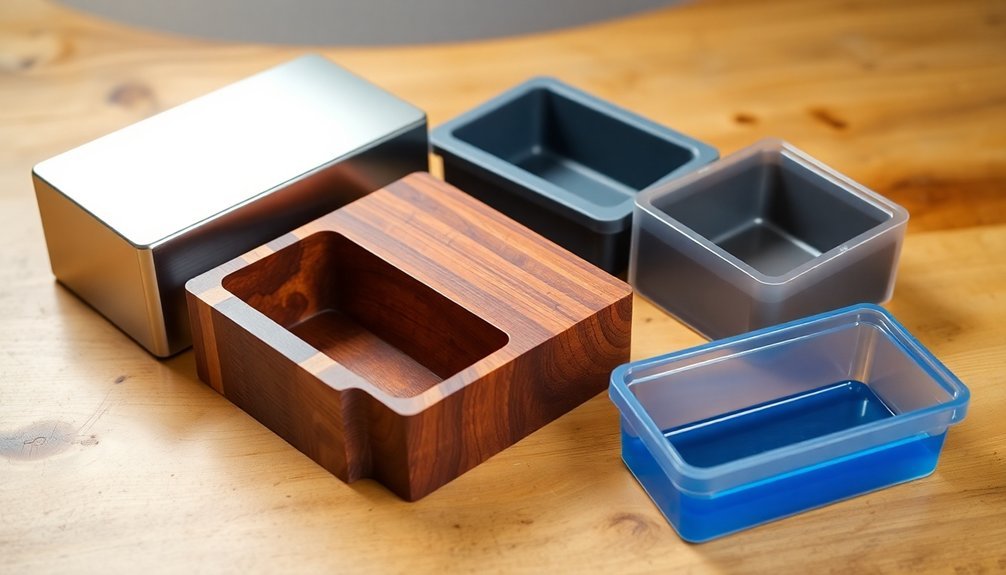
Material selection stands at the heart of successful soap making, with each mold type offering distinct advantages for crafting the perfect loaf.
When you're choosing your mold material, you'll need to take into account key properties that affect your soap's success.
Silicone offers flexibility that makes it easy to unmold your soap without extra preparation.
Flexible silicone molds make soap removal a breeze, eliminating the need for any prep work or special release agents.
If you're looking for excellent insulation, wooden molds are your best bet for achieving consistent gel phase, though you'll need to line your mold with freezer paper.
While plastic molds are budget-friendly, they can be tricky to unmold.
HDPE molds provide durability for puck soaps but might require lining depending on your formula.
For those who love watching their soap develop, acrylic molds offer visibility during the process, though they're susceptible to warping with repeated use.
Silicone Molds: Benefits and Limitations
While many soap makers debate their preferred mold materials, silicone stands out as a versatile option that combines convenience with professional results. You'll find these molds are easy to use, offering effortless unmolding thanks to their flexible nature. They're durable and long-lasting, handling temperatures up to 400°F for both cold and hot process methods.
| Benefits | Limitations |
|---|---|
| Easy unmolding | Slower hardening process |
| Professional-looking bars | Requires sodium lactate |
| Temperature resistant | Sensitive to harsh cleaning |
| Smooth, sharp edges | Can be more expensive |
To maximize your silicone molds' lifespan, proper care is essential. Avoid harsh scrubbing or dishwashing, as these can damage the material. While the hardening process may take longer, you can speed it up by adding sodium lactate to your soap formula.
Wooden Mold Construction and Care
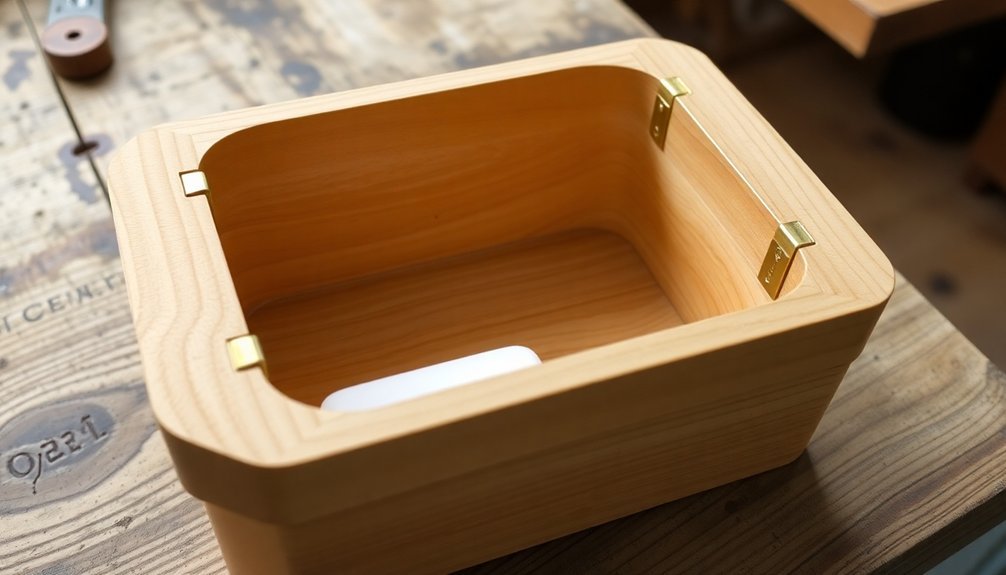
When crafting soap in wooden molds, you'll benefit from their superior insulation properties and the natural warmth that pine construction provides during saponification. Non-treated pine is your best choice for wooden soap molds, offering both durability and excellent heat retention.
To protect your mold and guarantee easy soap removal, always line it with grease-proof paper. This prevents soap from sticking and protects the wood from moisture damage. When building your own mold, incorporate disassemblable sides or a removable bottom for hassle-free unmolding.
Don't forget regular maintenance to keep your molds in top condition. Clean them with mild soap and warm water after each use, and periodically check for warping.
Sanding down rough edges and keeping the wood dry between uses will greatly extend your mold's lifespan.
Metal Molds: Durability and Performance
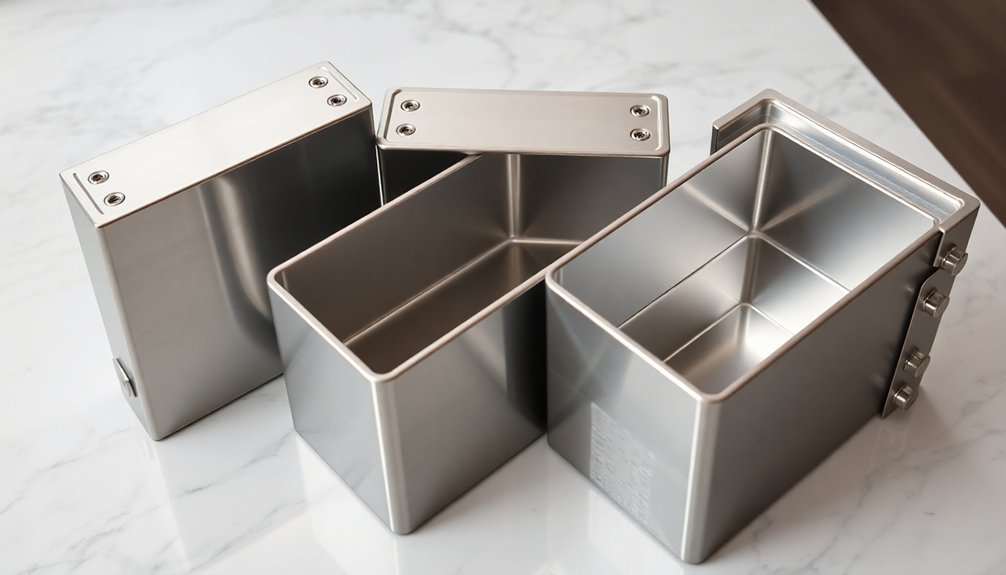
Professional soapmakers often choose metal molds for their exceptional durability and consistently reliable results. When you invest in stainless steel or aluminum molds, you'll get superior performance that withstands repeated use without warping.
These metal molds excel at insulation, helping maintain ideal temperatures during the essential gel phase of soap making.
While they're pricier than other options, you'll find their durability makes them cost-effective in the long run. For cold process soap, you'll need to line your metal molds with parchment or freezer paper to prevent sticking and guarantee easy removal.
You can choose from various sizes and shapes to match your production needs, from single loaves to larger slabs. The superior heat retention and structural integrity of metal molds contribute greatly to producing higher-quality finished soaps.
Plastic Mold Options and Considerations
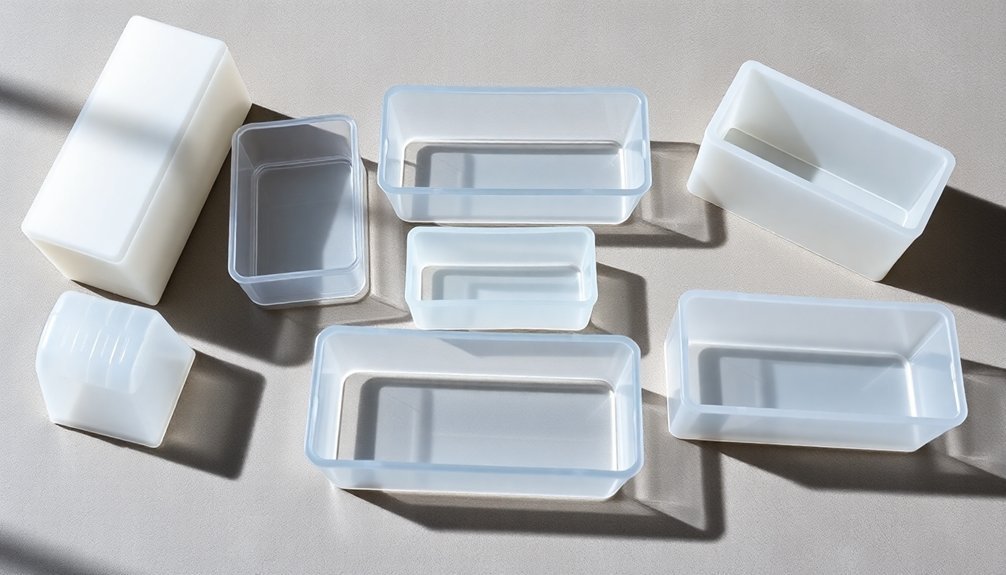
While plastic soap molds offer an affordable entry point into soap making, you'll find they're not as durable as their metal counterparts and may need replacement after repeated use.
You can extend your plastic mold's lifespan by using mineral oil or cosmetic silicone as release agents, but you'll still need to handle them with care during unmolding to prevent bending or cracking.
A common frustration you'll encounter with plastic molds is their tendency to develop soda ash on soap surfaces and their limitations with hot process techniques due to heat sensitivity.
Durability vs. Cost Analysis
Three key factors drive soap makers to evaluate plastic molds: affordability, accessibility, and versatility. When you're starting your soap making journey, plastic molds offer the most cost-effective entry point compared to silicone or metal alternatives.
While plastic molds are affordable, you'll need to weigh their shorter lifespan against their initial savings. They're prone to warping and cracking, especially in high-temperature conditions. You'll find that investing in high-quality plastic molds can provide better durability and easy release features, though they'll still require careful handling.
Consider your production scale and budget. If you're making small batches occasionally, basic plastic molds might suffice.
However, if you're planning frequent production, investing in more durable materials could save you money in the long run despite higher upfront costs.
Common Issues With Plastic
Understanding plastic mold challenges can help you make informed decisions about your soap-making equipment. While plastic molds offer versatility in shapes, you'll need to handle them carefully during the unmolding process to prevent bending or breakage.
When working with cold process soap, you'll face longer curing times, sometimes up to a week. You can improve the release of soap by applying mineral oil or cosmetic silicone as a lubricant.
Watch out for soda ash formation on your soap's surface, though you can prevent this by spraying alcohol after pouring.
An essential consideration is ensuring your plastic molds don't contain aluminum, as it can trigger unwanted reactions with soap ingredients.
Despite these challenges, plastic molds remain popular for both melt and pour and cold process soap making.
Lining Materials and Techniques
When choosing between parchment paper and plastic wrap for your soap mold, you'll find parchment offers superior durability and easier soap removal.
You can also use freezer paper as an excellent alternative, taking advantage of its waxed side to prevent sticking.
To prepare freezer paper properly, cut it to size with the waxed side facing your soap mixture, and press the edges firmly against your mold's interior.
Parchment Vs Plastic Wrap
Choosing between parchment paper and plastic wrap for your soap mold lining can greatly impact your final product's quality.
Parchment paper offers superior durability and sticking resistance, making soap removal considerably easier. During the gelling phase of cold process soap, parchment paper's heat resistance proves invaluable.
Key advantages of parchment paper over plastic wrap:
- Better surface protection, preventing imperfections on your soap bars
- Enhanced durability that reduces tearing during the pouring process
- Superior heat resistance for optimal performance during soap curing
- Easier removal with minimal risk of damaging your finished product
While plastic wrap's affordability makes it tempting, you'll find parchment paper's performance justifies the investment.
For consistent, professional results in your mold lining, parchment paper emerges as the clear winner, especially when considering long-term benefits and final product quality.
Freezer Paper Prep Methods
Proper freezer paper preparation makes a significant difference in achieving professional-looking soap bars. When you line a mold with freezer paper, you'll want to cut it precisely to size, ensuring complete coverage of both bottom and sides.
Remember to position the paper with its shiny side facing inward to create a non-stick surface for your soap mixture. For secure placement, fold the paper's edges over the mold's rim and tape the edges firmly in place.
This step is essential as it prevents any potential leakage while pouring your soap mixture. You'll appreciate this careful preparation once your cured soap is ready, as the freezer paper can be easily peeled away without leaving any residue behind, resulting in clean, smooth soap bars that look professionally crafted.
Temperature Effects on Different Mold Types
Since temperature plays a crucial role in soap-making, understanding how different mold materials react to heat can make or break your final product.
While silicone molds are heat-resistant up to 400°F, they'll slow down your soap's hardening process. Wooden molds offer excellent insulation for saponification but can warp from hot soap batter.
Here's how temperature affects your mold choices:
- Plastic molds lack heat resistance and may warp during curing.
- Acrylic molds provide visibility but can crack under extreme temperatures.
- HDPE and PVC molds need proper lining despite being heat-resistant.
- Wooden molds excel at temperature management but require monitoring to prevent softening.
When selecting your mold material, consider your soap-making method and temperature requirements to maintain structural integrity throughout the process.
Mold Size and Batch Capacity
Beyond temperature considerations, the size of your soap mold directly impacts your production capacity and workflow efficiency.
When planning your soap recipe, remember that the ideal batch capacity is around 62 ounces of oil, yielding about 4 pounds of finished soap.
You'll find loaf mold sizes ranging from 2 lb to 7.5 lb capacities, with the 12 x 3.5 x 3.5-inch mold being particularly versatile for various production goals.
If you're among hobbyists starting your soap making journey, consider 2 lb silicone molds – they're easier to handle and perfect for experimenting with different scents without creating excess inventory.
Before selecting your mold size, don't forget to check your oven dimensions, as larger molds mightn't fit in standard-sized ovens.
Cost Analysis of Mold Materials
When evaluating soap mold materials, you'll find significant price variations that can impact your initial investment and long-term costs. A thorough cost analysis reveals that silicone molds offer excellent value at $10-30, providing durability and reusability for multiple batches.
Consider these price points for various soapmaking molds:
Price points vary widely across soapmaking mold types, with options available to match every budget and production need.
- Wooden molds ($25-50) require additional expenses for lining materials.
- Budget-friendly plastic molds ($5-15) work well but may need replacement sooner.
- Custom molds ($30-100) offer unique shapes but come at a premium.
- DIY options ($1-5) serve as the most economical choice for beginners.
While plastic molds might seem the most attractive initially, they're not always the most cost-effective long-term solution. Silicone molds often provide the best balance between durability and affordability for regular soapmakers.
Cleaning and Maintenance Requirements
You'll need to adopt different cleaning methods based on your mold material, with silicone requiring only soap and water while wooden molds need careful wiping with a damp cloth to prevent damage.
To avoid residue buildup, clean your molds immediately after each use and pay special attention to corners and crevices where soap can accumulate.
For long-term durability, make certain your molds are completely dry before storing them, and keep silicone molds flat without heavy items stacked on top.
Daily Cleaning Best Practices
Proper maintenance of soap loaf molds starts with consistent cleaning practices after each use.
You'll need to thoroughly clean your molds with warm water and dish soap to prevent problematic residue buildup that can affect future batches.
For the best cleaning results, follow these essential steps:
- Rinse your soap molds immediately after use with warm water to remove loose residue.
- Apply dish soap and gently clean without abrasive tools that could damage silicone molds.
- For stubborn residue, use white vinegar as a natural cleaning solution.
- Allow molds to dry completely before storing to prevent moisture-related issues.
If you're using silicone molds, you can place them on the top rack of your dishwasher for easy cleaning, but avoid high-heat settings that might compromise the material's integrity.
Preventing Residue Buildup
Since residue buildup can compromise soap quality and mold performance, implementing preventive maintenance strategies is vital for long-term success.
You'll need to clean your soap molds regularly with warm water and dish soap to prevent stubborn residue from accumulating over time.
For silicone molds, use soft sponges or cloths during the cleaning process to protect their surface. You can also run them through the dishwasher for convenience.
If you're working with wooden molds, wipe them carefully to avoid water damage. Adding white vinegar to your cleaning routine will help remove persistent soap residue effectively.
Before storing your molds, make sure they're completely dry to maintain the longevity of the molds and prevent any deterioration.
This simple but important step will protect your investment and guarantee consistent soap-making results.
Storage and Care Tips
Taking good care of your soap molds extends their lifespan and guarantees consistent, high-quality results. To maintain quality and avoid sticking issues, you'll need to establish proper cleaning and storage routines for both silicone and wooden molds.
- Store silicone molds in cool, dry storage containers, and don't stack heavy items on top that could alter their shape.
- Hand wash your clean soap molds with warm water and dish soap, using white vinegar for stubborn residue.
- Let molds dry completely before storing to prevent potential mold growth.
- Line wooden molds with freezer paper to protect them from raw soap damage.
Storage and Longevity Factors
Understanding how to store and maintain your soap molds will dramatically affect their lifespan and performance. For the best longevity, you'll want to store molds in a cool, dry place without stacking heavy items on top, which helps prevent warping and damage.
Silicone molds offer the greatest durability and can serve you for years with proper care. If you're using wooden molds, you'll need to commit to regular maintenance and always line them with grease-proof paper to prevent moisture damage.
Plastic molds require extra attention since they're vulnerable to heat warping and cracking.
Don't skip cleaning your soap molds after each use – warm water and dish soap will remove residues that could affect future batches. This simple maintenance routine works effectively across all mold materials and guarantees continued reliable performance.
Environmental Impact of Mold Choices
When choosing soap molds, your environmental impact deserves careful consideration alongside functional needs. Your choice of eco-friendly materials can greatly reduce waste and protect our planet.
Consider these sustainable options:
- Silicone molds offer durability and reusability, making them an excellent long-term investment that reduces single-use plastic waste.
- Wooden molds from sustainably managed forests provide a biodegradable option with minimal carbon footprint.
- Recycled containers give new life to existing materials while creating unique soap shapes.
- HDPE molds, when properly recycled, minimize landfill impact.
Professional Grade Mold Selections
Professional soap makers demand superior molds that deliver consistent results and streamlined production. When you're selecting professional-grade equipment, you'll find several excellent options that meet industry standards.
Silicone molds lead the market for their non-toxic properties and easy unmolding capabilities. You won't need additional lining, and they'll produce smooth, flawless bars every time.
Silicone molds create perfect soap bars every time while eliminating the need for liners, making them the professional's top choice.
HDPE molds offer outstanding durability, though you might need to line them depending on your soap formula. If you're creating intricate designs, acrylic molds let you monitor the soap-making process through their clear walls, despite their higher cost.
Don't overlook wooden molds – they're time-tested favorites among professionals. When properly lined with freezer paper, they provide superior insulation that accelerates saponification and enhances your final product's quality.
Frequently Asked Questions
What Is the Best Material for Soap Molds?
You'll find silicone molds are your best choice for soap making. They're flexible, durable, and don't need lining. While wooden molds offer great insulation, silicone's easy release makes it the top option.
What Is the Best Wood for Soap Molds?
You'll find untreated pine is your best choice for soap molds due to its affordability and insulation properties. Cedar's also excellent for moisture resistance, while maple and birch offer durability for sharp edges.
How Do You Keep Soap From Sticking to Mold?
You can prevent soap from sticking by using mold release spray, dusting with cornstarch, or lining molds with parchment paper. For wooden molds, use freezer paper, and if soap sticks, freeze briefly for easier removal.
Are Silicone Molds Good for Soap Making?
Yes, you'll find silicone molds excellent for soap making. They're flexible, non-toxic, and durable. You won't need to line them, they're easy to clean, and your soaps will release smoothly every time.
In Summary
Whether you're choosing silicone, wood, metal, or plastic molds for your soap making, consider your specific needs and production volume. You'll want to weigh durability, ease of cleaning, and cost against your sustainability goals. While silicone offers flexibility and wood provides excellent insulation, all materials have their place in soap crafting. Select what works best for your process, and you'll create beautiful, professional-quality soap loaves.

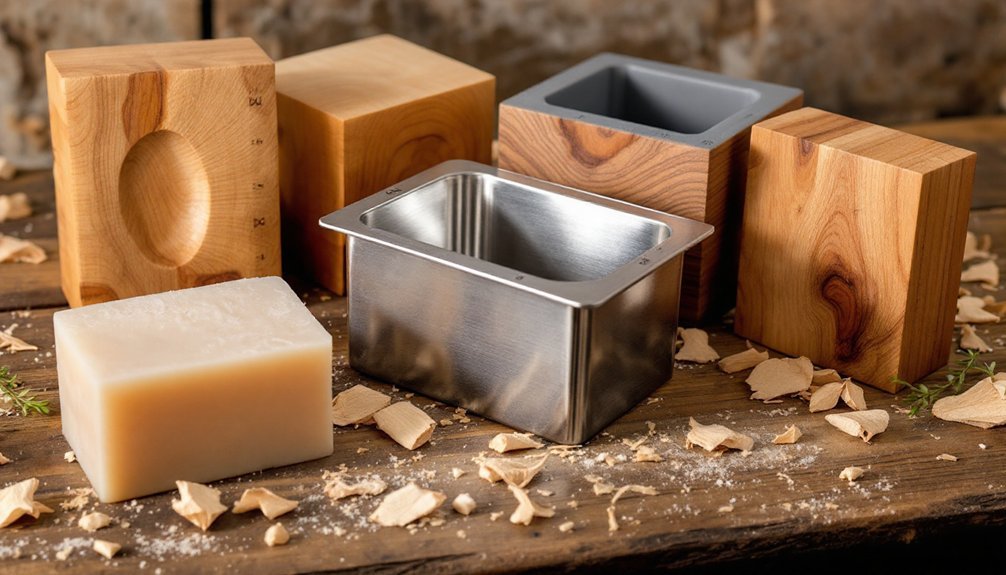



Leave a Reply